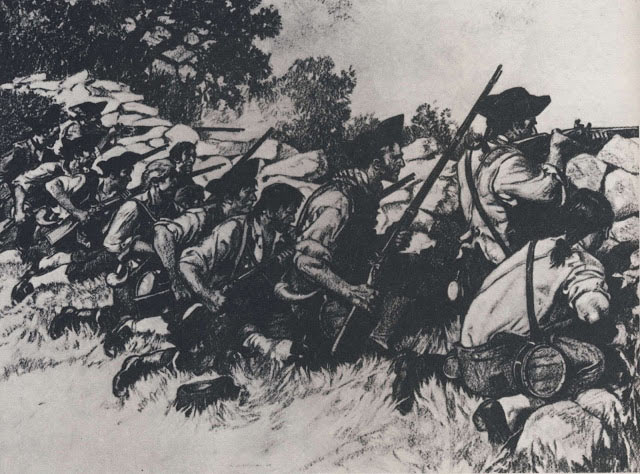Battle of Hubbardton Facts: Overview
Date: July 7, 1777
Region: New England Colonies
Opposing Forces: British - 1,030; Americans - 1,100

British Perspective: In the spring of 1777, Major General John Burgoyne was dispatched to Québec to take charge of British forces in Canada and lead an offensive into western New York, where he was to crush Patriot forces in that region. He would then march south to Albany and join forces with Gen. William Howe’s army for additional offensive operations.
Burgoyne left 3,700 troops in Canada with Gen. Sir Guy Carleton while he led a 9,100-man expeditionary force south along Lake Champlain to capture Fort Ticonderoga. At the same time, another British force, about 2,000 men led by Lt. Col. Barry St. Leger, would march around to the west and attack Patriots operating in the Mohawk Valley before moving to Albany.
Howe, meanwhile, would lead the main British army north up the Hudson River from New York City to join St. Leger and Burgoyne at Albany. If successful, the three-pronged offensive would crush the rebellion in New York and separate New England from the rest of the 13 colonies.
It was an ambitious plan, but if successfully offered, perhaps the best way to cripple the rebellion and turn the tide of the war decisively in the Crown’s favor.
American Perspective: General Burgoyne’s invasion from Canada forced the scattered Patriots to funnel south to Fort Ticonderoga, where they joined with men led by Maj. Gen. Philip Schuyler, the commander of American troops in western New York (Northern Department of the Continental Army).
One of his subordinates, Gen. Arthur St. Clair, was assigned to defend Fort Ticonderoga and the surrounding region. When Burgoyne arrived and secured high ground southwest of the fort on Mt. Defiance, St. Clair ordered his men to evacuate (some by water, others by land) after dark on July 5.
Colonel Pierce Long, tasked with covering the main withdrawal route of American forces, was nearly trapped in Skenesboro on the afternoon of July 6, but he set fire to the town and slipped off in the confusion toward Hubbardton, Vermont.
The Battle
Warner’s men held an advantageous position (known today as Monument Hill), but without a proper advance guard, the position was nearly worthless against a determined and veteran enemy.
Fraser attacked with 750 men from the west at 4:40 a.m. The initial wave struck a regiment of New Hampshire troops commanded by Col. Nathan Hale (not the former spy Hale) while they were cooking breakfast along with a small stream.
The assault routed the New England infantry.
Warner and another regimental commander, Col. Turbott Francis, hastily formed their regiments and unleashed a volley into the front line of attackers, killing and wounding two dozen, including some high-ranking field officers.
The fighting front stabilized into a 900-yard line stretching from 1,200-foot rocky and wooded Zion Hill on the American left into the woods on the far right. Forced to advance under fire uphill, the redcoats had a harder time of it.
A good tactician, Fraser quickly realized the hill was the key terrain on the field and stripped his own left flank to increase the punch on his right. Either forced back or by design, the American left flank on the hill slowly bent backward, which made it harder for the British to find the flank and turn and collapse it.
Colonel Francis commanded on the American right and gained ground there with his Massachusetts infantry against the weakened British left flank. All along the line, the Patriot infantry enjoyed the advantage of fighting Indian style from behind trees and rocks, tactics the British did not fully understand or train for. The fighting was at close quarters, and the result was mounting British losses.
Fortunately for Fraser, von Riedesel arrived with his grenadiers and jägers. He, too, was a capable officer and quickly realized the difficulties they were facing that morning. Without wasting time, the German general pitched in his troops as quickly as they arrived, some directly forward and others around to find and roll up the American flank.
Von Riedesel ordered his band to play and his men to sing, which had a tendency to unnerve enemy troops and convince them they were facing overwhelming numbers. Within a few minutes, Colonel Francis was shot dead (after the battle, von Riedesel saw to it he received a Christian burial), the grenadiers had found Francis’s flank, and the Massachusetts regiment was falling back.
When Fraser’s men finally launched a bayonet attack against the Vermont troops on the high ground, Warner knew he had pushed his luck as far as possible. Instead of ordering a traditional withdrawal, he spread the word to “scatter and meet me back at Manchester.” Most of Warner’s men managed to reassemble and continue evading the enemy southward to Bennington, Vermont.
The heavy battle had seesawed back and forth in the Vermont thickets for more than two hours. One of the war’s leading historians claims the forgotten battle of Hubbardton was “as bloody as Waterloo” when one considers the proportion of casualties to the numbers involved (roughly one in four of those involved in the fighting was either killed, wounded, or captured).
However, estimates of the losses on both sides vary considerably.
Online Resources
- Wikipedia - Battle of Hubbardton
- Battles of the American Revolution
- The History Junkie’s Complete Guide to the American Revolutionary War
- The History Junkie’s Guide to the American Revolutionary War Battles
- The History Junkie’s Guide to the American Revolutionary War Timeline
- The History Junkie’s Guide to the 13 Original Colonies
